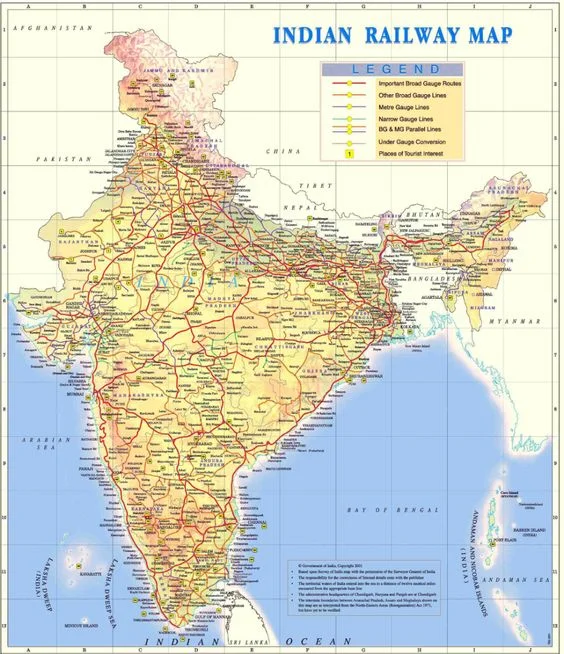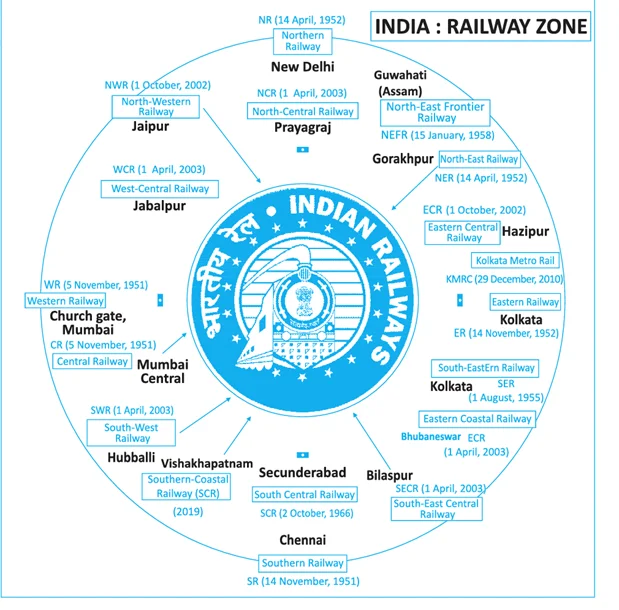India boasts the fourth-largest railway system globally, behind only the US, Russia, and China. With a vast network spanning over 126,366 km of tracks and over 7,335 stations, Indian Railways is a crucial mode of transportation for millions.
Railways in India: Achievements and Goals
- Origin: Railway was first introduced in 1853, from Bombay to Thane during the Governor Generalship of Lord Dalhousie.
- Global Status: India ranks 4th globally in railway infrastructure, trailing only the US, Russia, and China.
- Railways Infrastructure: Indian Railways encompasses 126,366 km of track and 7,335 stations.
- Track Development: During 2022-23, 5,243 km of track was laid, with a record daily average of 14.4 km.
- Daily Operations: include 13,523 passenger trains and 9,146 freight trains daily.
- Freight loading: reached a record high of 1,512 MT in 2022-23, with a target of 2,024 MT by 2024.
- High-speed Rail Project: The Mumbai-Ahmedabad high-speed rail project, costing $14.27 billion, is underway.
- Railway Electrification: Indian Railways aims for complete electrification by 2023, saving $1.55 billion annually.

-
- Over 61,813 km of Broad-Gauge network has been electrified, advancing towards 100% electrification.
- Significant progress has been made in railway electrification, with 38,650 km achieved by Oct 2023.
- Wi-Fi: It has been installed at 6,089 railway stations nationwide.
- Green Initiatives: More than 1,000 stations have been solarized to support green initiatives.
- Safety System: Automatic Block Signaling (ABS) has been implemented along 3,946 route km.
- Kavach, a safety system, covers 1,465 route km and 139 locomotives across several states.
- Vande Bharat Trains and Gati Shakti Cargo terminals: Plans include manufacturing 400 Vande Bharat Trains and developing 100 PM Gati Shakti Cargo terminals in the next three years.
- Gauge Conversions: From 2014 to 2022, 1,544 km of new lines, gauge conversions, and doubling projects have been commissioned, showing a significant increase compared to the previous period.
-
- 18 Zones: The Indian Railways has been divided into 18 zones: Northern Railway (Largest), North Eastern Railway, Northeast Frontier Railway (Smallest), Eastern Railway, South Eastern Railway, etc.

-
- 100% FDI: is allowed in railway infrastructure under the automatic route.
- Classification based on the width of track: Broad gauge (1.676 metres), Metre gauge (1m) and Narrow gauge (0.762m or 0.610m; generally confined to hilly areas)
- Indian Railways has two UNESCO World Heritage Sites:
- The Chhatrapati Shivaji Maharaj Terminus, Mumbai (2004) and
- The Mountain Railways of India (1999, 2005, 2008): Darjeeling Himalayan Railway, Nilgiri Mountain Railway, Kalka-Shimla Railway.
- Railway Infrastructure Projects in India:
- Dedicated Freight Corridors (DFCs):
-
- Eastern DFC (EDFC): 1,856 km long from Ludhiana (Punjab) to Dankuni (West Bengal); Covers Punjab, Haryana, Uttar Pradesh, Bihar, Jharkhand and West Bengal.
- Western DFC (WDFC): 1,504 km long from Dadri (UP) to Jawaharlal Nehru Port (Maharashtra); Covers Haryana, Rajasthan, Gujarat, Maharashtra and Uttar Pradesh.
| The Diamond Quadrilateral is an Indian Railways project to establish a high-speed rail network that will connect the four mega cities of India, viz. Delhi, Mumbai, Kolkata and Chennai |
| Trans-Continental Railway Lines |
| Trans–Siberian Railway (Russia) |
St. Petersburg (west) to Vladivostok (east) |
| Trans–Canadian Railways |
Halifax (east) to Vancouver (west) |
| Australian Trans–Continental Railway |
Perth (west coast) to Sydney (east coast) |
| Orient Express |
Paris to Istanbul |
Conclusion
Railways in India continue to evolve, with projects like high-speed rail networks and dedicated freight corridors transforming the nation’s transportation infrastructure. As India marches towards its vision of modernization and connectivity, its railways remain a symbol of progress and development, shaping the future of transportation in the country.
![]() June 24, 2024
June 24, 2024
![]() 7045
7045
![]() 0
0

